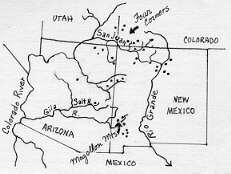 The
Pueblo Indians of New Mexico and Arizona are descendants of the first people
to enter the Americas, perhaps 20,000 years ago. These earliest groups, called
Paleo-Indians, encountered an environment very different from that of today.
The climate was cooler and wetter; there were glaciers on top of the Sandia
Mountains and small shallow lakes called playas on the west mesa and a large
lake in the Estancia Basin to the east of the Sandias. A wide variety of exotic
animals lived here then--mammoths, saber-toothed tigers, and dire wolves. Paleo-Indian
lifeways were apparently centered on the hunting of large game, but there was
still a need to collect plants and seeds, and the people moved their campsites
often and over great distances.
The
Pueblo Indians of New Mexico and Arizona are descendants of the first people
to enter the Americas, perhaps 20,000 years ago. These earliest groups, called
Paleo-Indians, encountered an environment very different from that of today.
The climate was cooler and wetter; there were glaciers on top of the Sandia
Mountains and small shallow lakes called playas on the west mesa and a large
lake in the Estancia Basin to the east of the Sandias. A wide variety of exotic
animals lived here then--mammoths, saber-toothed tigers, and dire wolves. Paleo-Indian
lifeways were apparently centered on the hunting of large game, but there was
still a need to collect plants and seeds, and the people moved their campsites
often and over great distances.
As the climate of the Southwest gradually changed to become more like the deserts we see today, the exotic animals hunted by the Paleo-Indians died off, and so did the Indians' nomadic way of life.
By 8,000 to 9,000 years ago, the beginnings of a different kind of adaptation and culture called the Archaic emerged in the Southwest. As populations grew, smaller areas were left for hunting. The game was smaller too--mostly deer, antelope, or rabbit, and there was a much greater dependence on wild plants and seeds than before. The Archaic way of life was well suited to the environments and lasted a very long time, probably at least until the birth of Christ. Then several major changes took place. The earliest dwellings, which were shallow, round depressions scooped out of the sand and covered with brush roofs, appeared by about 5,000 years ago. Around 500 B.C. the first evidence of one of the greatest changes in living appears--agriculture, particularly the growing of corn.
By about A.D. 500, early Puebloan life had begun to focus on agriculture although people still hunted and gathered wild foods and were still somewhat mobile in terms of moving the places where they lived. But farming created the need for less mobility and small villages with several dwelling started to appear along the Rio Grande and in the Rio Puerco Valley. These villages had two to twelve pithouses, which were dwellings dug into the ground with ramped entrance ways, roof support posts, central fireplaces, and domed roofs covered with brush and mud. Pits for storing wild and grown food were located both inside and outside the pithouses. Dogs and turkeys were the first animals to be domesticated. It was then that one of the great inventions in the history of the Southwest--pottery--first appeared.
Pithouse sites continued to be occupied until after A.D. 1000. But the traditional pueblo way of life, which is characterized by year-round living in above-ground villages and an economy based on cultivating corn, peas, and squash, did not become well established in Albuquerque area until about A.D. 900. Before that, the population centers of the Pueblo ancestors were at higher elevations either north (in the Four Corners) area or south (in the Mogollon Mountains). The Middle Rio Grande was not avoided, but population density here was relatively low compared with surrounding areas. Small pueblos, mostly made from stone, were built in the Sandia foothills and Tijeras Canyon area during A.D. 1100--1200.
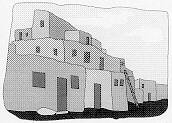 |
Between about A.D. 1200 and 1540, population density in the Rio Grande Valley increased as both the Four Corners area and the Mogollon Mountains were abandoned. The reason for these abandonments is not clear. It has been suggested that a period of droughts from A.D. 1275 to 1299 led to some of these abandonments, and slightly more erratic rainfall patterns made support of high populations away from permanent water sources such as the Rio Grande untenable. In any case, by about A.D. 1300, the Albuquerque area experienced a virtual population explosion. Numerous pueblo villages, many made of adobe and standing several stories high, were built on both sides of the river. At least 40 of these villages have been found between Bernalillo and south of Belen. Many villages had hundreds of rooms; the largest ones had over a thousand rooms and probably several thousand inhabitants.
Classic period pottery is distinctive not only because of its use of reds and multiple colors, but also because of the invention of lead-based glaze paints on bowls and jars. The rich spiritual and religious lives of these Puebloan ancestors is reflected in wall paintings found in underground ceremonial rooms called kivas. Most of the petroglyphs (images carved or inscribed on rock) found on the west mesa escarpment have a strong connection to the kiva mural paintings and are thought to have been made by Classic period priests or elders from nearby villages.
All of the modern pueblos have migration stories that relate abandoning former homes (for various reasons) and founding the present villages. When the first expeditions of Spaniards reached New Mexico, there were many more pueblo villages, both along the Rio Grande and east of the Sandia and Manzano, than there are today. The introduction of European diseases, horses, and firearms initiated the reduction of Native American population. Modern pueblos reflect an attempt to incorporate traditional values and modes of life, while adjusting to the dislocations caused by first the Spaniards and later the Anglos.
Corn (Zea mays) was the dietary staple, and the presence of good agricultural land a necessary condition for the establishment of a village. Locations were selected where the growing season was at least 120 days and where there was water for both crops and domestic use. Prehistoric puebloan agriculture relied on two techniques to ensure a harvest. In cases where stream water could be diverted for crops, diversion ditches and canals were built. In the Sandias and Manzanos and to the east, farmers depended on rainfall, either directly or indirectly (water captured in seeps or springs). Many devices were used to conserve both soil and moisture: gravel mulch on garden plots; terraces on slopes, and check dams across arroyos. Generally, the unpredictability of rainfall was dealt with by planting fields in several different topographic settings so that if a crop could not be raised in one, it could be in another. Corn depletes nitrogen from the soil, but the Puebloans planted beans, which are nitrogen fixing, in the same field. They also grew squash; and where the growing season was long enough, planted cotton as well. Agricultural tools consisted of wooden digging sticks and hoes of stone or animal bone.
Despite the relative sophistication of pueblo agriculture, the desert environment did not allow a living by farming alone. Prehistoric Puebloans gathered a variety of wild plants including piñon nuts, Indian rice grass, chenopodium (goosefoot), amaranth seeds, hackberry, squawberry, serviceberry, choke cherry, wild plum, and cacti (especially prickly pear and cholla buds. Hunting was also important because animal meat provided fat and a source of protein other than beans. Traps and snares were used for small game such as pocket gophers, ground squirrels, and lizards. Large game animals, which included Rocky Mountain bighorn sheep, deer, antelope, and bison were hunted with bows. Rabbits were hunted in drives conducted periodically throughout the year.
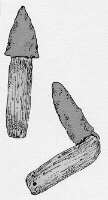 |
PREHISTORIC "JACKKNIVES"
|
Equipment for food procurement and processing required a variety of raw materials. Wood was necessary for digging sticks and bows. Arrowheads, knives, and scrapers were made of cryptocrystalline rocks (such as obsidian, chert, and chalcedony), which could be shaped and resharpened by flaking. Sandstone, limestone, or basalt was used to make the grinding stones (manos and mutates) used to process corn and wild seeds. Pottery jars and bowls were manufactured for cooking, storing, and serving food and water. Pottery making required a source of fine clay and tempering material, which helped prevent shrinking and cracking of vessels. Sand, mica, schist, and ground ceramic fragments were used as a temper. Serving dishes were often decorated by painting before firing. Organic pigments, such as the black paint made from the Rocky Mountain bee plant, and mineral-based paints such as the pigment made from hematite, were used. From about A.D. 1300 to the 1700s, Pueblo Indians in the central Rio Grande area used a glaze paint (produced by grinding up lead from local galena sources) to decorate serving bowls and jars.
Some food, salt, and probably hides were traded among the prehistoric villages. Pottery was widely traded as were turquoise and marine shell used for jewelry. Cotton and hides were used for clothing. Baskets made of reeds and yucca fiber were probably used for both winnowing and carrying. One common tool was a bone awl (usually made of deer or antelope bone) for basket weaving. Turkeys were kept, probably for both feathers and meat. The only other domestic animal was the dog, apparently not used for food. A variety of birds were either hunted or captured, presumably for their feathers--hawks, owls, eagles, bluebirds, quail, doves, and waterfowl.
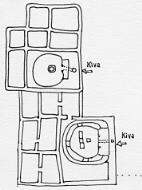 |
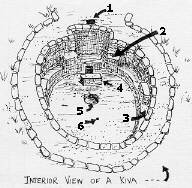 |
The group plans of prehistoric villages vary, but all include contiguous rectangular rooms (used for living rooms and storage); ceremonial rooms, or kivas, which were either rectangular and incorporated in blocks of living rooms, or separate, semi-subterranean, circular rooms; plaza areas; and trash mounds. Rooms were constructed of either masonry set in adobe mortar or of coursed adobe (adobe bricks were introduced by Europeans). Timber was cut for vigas and latillas used to support flat adobe roofs. A great deal of timber must have been cut by each village for the firewood, necessary for both cooking and heat in winter. Stone axes of basalt or other hard stone were used.
The prehistoric Puebloans, like all other human beings, required food, water, shelter, the comfort of others , and a sense of security in dealing with the natural environment. Without wheeled vehicles, trains or airplanes, telegraphs, telephones, radios, or writing, each individual had at once to be both master of several kinds of skills and dependent upon other members of his community. With the difficulties and uncertainties of living in the semi-desert, people had to work cooperatively, according to schedule. Corn had to be planted before the rains and harvested before the frost; nuts had to be gathered as soon as they ripened.
If one family's crops were destroyed, there had to be neighbors and kinsmen to whom they could turn. Access to the land and its products was acquired through ties of the family and village. Knowledge of how to treat their resources had to be learned from the experiences of other members of the community.
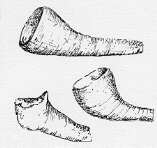 |
It should not be surprising that among the descendants of the ancient Puebloans, village harmony and respect for elders are important values. It has been noted that those aspects of life that are most problematic for a society are those more elaborated in ritual and religion. The prehistoric Pueblo Indians elaborated themes dealing with water and rain to ensure crops. Cloud blowers (pipes) produced smoke to simulate and attract clouds. Frogs, fish, and snakes were painted on ceramics and molded from clay. Shrines were often located in the mountains and near springs. The rain cloud motif was painted on seed jars and the walls of kivas. Certainly other aspects of prehistoric life such as curing disease and ensuring success in hunting and warfare must also have involved considerable ritual (as they do among us all today), but tangible remains of these activities are not a marked feature of the archeological record.
Sandia Pueblo, 14 miles north of Albuquerque on the east side of the Rio Grande, and Isleta Pueblo, 14 miles south of Albuquerque on the west side of the river, are both Tiwa-speaking pueblos. Their native names are Nafiat (dusty) and Tuei (town). Sandia Pueblo lands comprise 22,884 acres, (93 km2) and the village itself seems to have been occupied continuously since about 1300. Isleta's lands comprise 187,826 acres (760 km2) and the present village site cannot be dated earlier than 1500. The core population of both villages is probably made up of descendants of Puebloan peoples living in the Rio Grande Valley long before European contact. Both pueblos probably also received population increments from the now extinct Piro Pueblos, which existed before the conquest along the river south of Isleta and from the abandoned Saline Pueblos (Abo, Gran Quivera, and Quarai) of the Estancia Basin. In about 1880, Isleta welcomed and gave land to a group from Laguna Pueblo, a Kersean-speaking pueblo. The immigrants have intermarried with the native Isletans.
The populations of both Sandia and Isleta have grown considerably since the turn of the century. In 1900, Sandia's population was just 74 persons. In 1968, this figure was 248. During the same period, Isleta's population grew from 989 to 2,449. At both villages, there has been a recent trend toward building separate, "American-style" houses, closer to the highway than the older parts of town.
During prehistoric times, the inhabitants of both pueblos derived their living from the land. Use of land for farming was in accordance with the traditions of each village. Land used for hunting, firewood gathering, and for its minerals or other materials was not "owned" in our legalistic sense, but used by the people according to their needs. Since each village acted as an independent political unit, it is likely that a great deal of effort was expended keeping land disputes or resource disputes between villages at a minimum, inasmuch as the only "solution" to an irresolvable conflict would be warfare. As soon as the first Europeans moved into New Mexico, problems over land ownership arose that were "settled" (and "resettled") legally in accordance with the policy of the government involved.
During the period of Spain's control of New Mexico, pueblo land was defined in terms of land grants from the King of Spain, and these lands could not be sold. During the period from 1821 to 1846, when Mexico ruled New Mexico, pueblo land could be sold quite easily, andSandia Pueblo lost more than 21,000 acres (85 km2) of land in this manner. Finally, the U.S. government has renegotiated Indian land claims. Under the terms of the Reorganization Act of 1934, the pueblos were given considerable internal political autonomy. Since 1934, the pueblos have acquired land through permit, lease, exchange, or purchase under a federal land acquisition program.
Clearly however, none of the pueblos could be economically self-sufficient today given only their reservation lands. The residents of Sandia and Isleta continue to farm, and now have modern industrial equipment. Additional income to Isleta is gained through wage labor and through leasing tribal land for grazing or farming.
 |
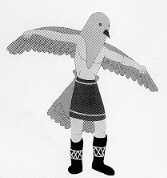 |
(Up to Section III, Back to The Built Environment - Bibliography, On to Hispanic Influence)